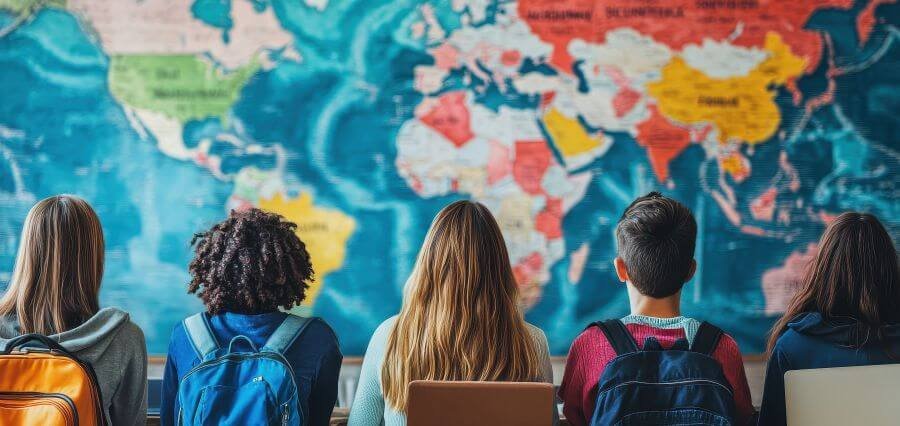For most of history, geographically defined education was the norm. Students were educated within their territorial boundaries, following the curriculum, culture, and availability of their geographic region. Although the localized model created highly mature community relationships, it restricted the potential for exposure to worldwide perspectives. The creation of online learning platforms, global collaborations, and global communications bridged these barriers, making students’ connections, collaborations, and learnings with teachers and students around the world possible. The classroom broke the walls and borders, and it became a global network in motion.
Technology as the Bridge
Technology remains the strongest enabler of global classrooms. Cloud computing, video conference, fast internet, and collaborative software enable immediate global interaction. It is not out of the question that a science project can be created by Seoul, Paris, and Toronto high school students with a student in Nairobi, or that a São Paulo university teacher can give a seminar to crowds on five continents in live time. Technology doesn’t just connect—it level the playing field, providing access to knowledge, experience, and cross-cultural exchange that ten years ago was out of reach.
Real-Time Cultural Exchange
Perhaps the best asset of global classrooms is their cultural literacy. Learning with classmates from other countries gets more than heady facts—compassion, knowledge, and flexibility are gained. Students learn firsthand about diverse traditions and customs. Discussions in the classroom over world history or world issues are informed by understanding from those who have experienced them. The firsthand exposure makes awareness of culture a learned, collective process, not a reading from a text.
Bridging Language Barriers
One of the biggest barriers to cross-border learning has always been language. Currently, language is being bridged with AI-powered translation software, speech recognition programs, and multilingual platforms. Instant translation during video calls, chat, and digital whiteboards is now a reality with such tools. While language skills continue to be a valuable skill set, the capacity to communicate and work in real time without linguistic delay has rendered global learning much more effortless. This technology ensures that the voice of the students is heard and recognized irrespective of their mother tongue.
Shared Challenges, Shared Solutions
Global classrooms also enable problem-solving collaboration across issues that transcend national boundaries. Issues such as climate change, public health, cybersecurity, and sustainable development cannot be solved in one country. When students collaborate on these areas, they do not just exchange ideas, but also apply innovative local knowledge that can be leveraged to strengthen innovative global solutions. Education is not anymore an instrument of individual advantage, but a platform for cooperation.
Offering Greater Access to Authorities
In a typical classroom, access to authorities is limited by locality. Learning networks worldwide alter this altogether. A physics class in a village can now have a live question-and-answer session with a Nobel laureate. A literature class can invite authors from across the world to talk about their books. These bridges are no longer the exclusive prerogative of elite schools-they are available to any school or learning community with internet access. This democratization of knowledge increases the collective sophistication and quality of education globally.
The Role of Educators in a Global Network
The global classroom transforms the teacher’s role from being custodians of knowledge to facilitators of learning. Teachers are now leading learners through immense repositories of information, authenticating sources, and filtering out numerous cultural viewpoints into their teaching. They are also interpreters of culture, enabling learners to comprehend and respect varying norms and views. This is a role that demands flexibility, being open, and being willing to learn together with the learners forever.
Challenges in Creating Global Classrooms
Despite the thrill of the possibilities of global learning, however, there are obstacles to it as well. The digital divide remains a major obstacle, with so many communities having no reliable internet connection or contemporary learning apparatus. Time zones will be an obstacle to one’s schedule, and differences in curricula may create issues of compatibility. Data privacy, security, and making the global learning environments safe and welcoming are also challenges. These issues need to be tackled by cooperative effort on the part of governments, technology companies, and schools.
Educating Students for a Globalized Future
Future workers will be more global and interconnected than ever. Students who are educated in the borderless classroom learn skills necessary to thrive in an environment so constructed—cross-cultural communication, shared use of technology, and functioning effectively in work environments that are multicultural. They are not only job skills but life skills that breed more empathetic, open-minded global citizens. Learning within this system is not about getting students ready for one market or one nation—it’s about getting them ready for a global society.
The Future of Global Learning
The global classrooms will become increasingly immersive as technology keeps evolving. Virtual and augmented reality will enable students to have virtual field trips to historical places, natural wonders, and even classrooms in other countries. AI-powered learning content adaptation will tailor learning to an individual’s needs but on a global mentality. The future also holds increased international cooperation towards establishing collective learning standards, where students can transfer from one school to another more globally.




